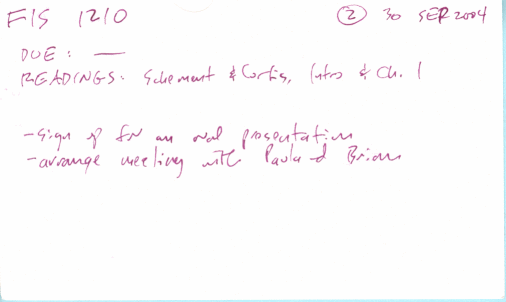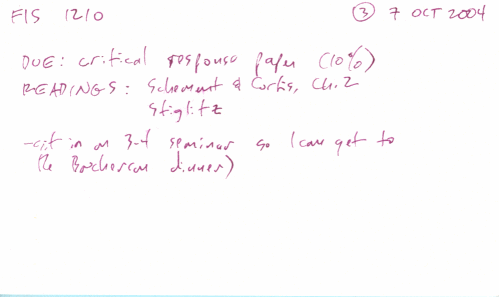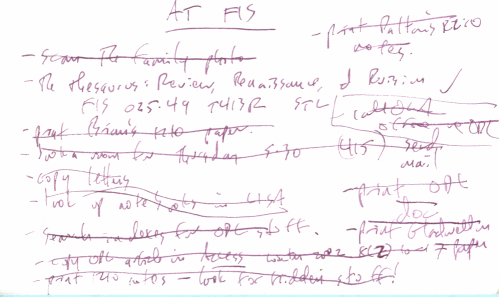I went to the Faculty of Information Studies at the University of Toronto, or, as we liked to call it, library school. I did two courses per term, and each course had thirteen classes, one per week, three hours long. There could be three to six assignments per course, and there are lots of readings (lots of assigned readings, if you know what I mean).
In my last year I figured out a new system for keeping track of all my coursework, and it worked very well. Everything was clearly laid out and easy to find, and I knew just what I had to do and when it was due. If I needed to do something in the library or talk to a prof in class, it was noted. With it, I stayed on top of things and had everything under control. It's based on David Allen's Getting Things Done system and index card systems such as the Hipster PDA and Getting Things Done with Index Cards. Here's how it works.
I had small two stacks of cards, one stack per course, each containing one card per class. I used one small clip on each, one in the bottom left and one in the bottom right so they could be put on top of each other and stay flat. Two more cards listed things to do for each course, and a third listed things to do when I was physically at school. I put these three on top of the rest in one big stack and used a big clip to hold everything together. Then I shoved the whole megillah in the front of my Filofax.
One Card Per Class
On these cards I would list the course number, the date, the number of the class (2-13, since I didn't do them for the first week), anything that was due that day, and any readings I had to do. When a class finished, I would move that day's card to the bottom of the stack and be faced with what I had to do for next week. In my other class I had two small assignments with no particular due date — small article reviews — and until I did them I wrote them down on each class card so I would always be reminded that they needed to be written.
Here are the cards for the second and third classes in FIS 1210, Information and Its Social Contexts:


The later weeks:
One To-Do Card Per Course
These cards listed things to do for the course that could be done anywhere: print off something, read an article, expand an idea, etc. When one side filled up, I turned it over, and when that filled, I started a new one. I went through a few of these for each course. Every time I looked at my cards, I could see what I had to do. When I got deep into writing a paper, I'd keep yet another list, but this time I'd use a piece of paper by my computer. That list was stationary stationery, but this one I took with me everywhere.

One Card for Things To Do at School
The last card was for things to do when I was actually at school: get a book, visit a professor, photocopy something. When I was in a class or in the library, a quick look at this reminded me of anything I needed to do before leaving. It felt nice to take care of some errands in the library and then cross them off the list.

What Else?
I wrote down all classes and assignment due dates in my Filofax, of course, and also drew a small calendar showing the term at a glance so I could see it all at once. I find that very helpful at the start of the term, but then I don't need it once things get going.
I don't know how well this would work for courses where there are two or three classes per week. Perhaps it could be changed from one card per class to one per week. The way my courses were scheduled it worked very nicely, and I wish I'd found this system earlier.
 Miskatonic University Press
Miskatonic University Press